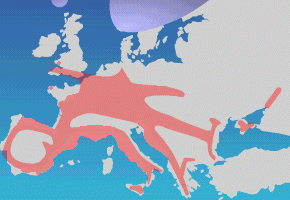Just found a quite nice site in French on European Paleolithic, that may be of much help in revieweing European Prehistory, specially for the common reader without archaeological background. Authored by Thierry Koltes the site is Ma Préhistoire (my prehistory).
I'll borrow some maps from there for the purpose of this post. They may not be perfect but are good enough to illustrate European Upper Paleolithic:
1. Aurignacian.
Since c. 41,000 BP. This culture probably originated in West and/or Central Asia but finds its finished form only in Central Europe (Hungary), from where it expands rapidly westward into Moravia, Germany and the Franco-Cantabrian region, as well as Italy and other less populated regions (southern Iberia, southern Britain, some Eastern offshots), displacing and eventually driving the Neanderthals to extinction.

A more detailed map of Aurignacian sites (not perfect either) can be found here. See also this post.
Genetics: mtDNA haplogroup U seems old enough to have participated in this first colonization of Europe. Haplogroup U8a has been directly associated with it but U5 and U6, as well as other U subclades maybe, could well have been involved as well.
Anthropometry: the human type associated with Aurigancian is an archaic-looking dolicocephalic person like Combe-Capelle man.
2. Gravettian.
Since c. 30,000 BP. The origins are uncertain but again we found it evolved in Central Europe. From there it expands to the West and also to the East. It is the last pan-European culture. Areas like Italy or Eastern Europe will thereafter use Gravettian derived technologies.

Genetics: mtDNA haplogroup H (or its HV precursor) could perfectly have been involved in this second wave. Y-DNA R1b shows a similar star-like pattern and distribution, so I speculate that maybe R1 could have arrived then, spreading eastward as R1a and westward as R1b. Another possibility is that only R1b was involved in this phenomenon, with R1b1b2 and R1b1b1 heading respectively to East and West.
Anthropometry: the type associated with this wave is Cro-Magnon.
3. Solutrean.
Since c. 22,000 BP. Evolved in SW Europe, probably in Dordogne, and its main area is the Franco-Cantabrian region. In Mediterranean Iberia a local Gravetto-Solutrean evolves instead. While not shown in the map, a late Hungarian Solutrean is also known to have existed as well.
Solutrean peoples developed art and technology a lot. They had needles and fishing hooks, for example.

4. Magdalenian.
Since c. 17,000 BP, transitional forms since c. 19,000 BP.
The ultimate origins of the transition may have been in Germany, where Aurignacian pervivences are known to have existed till very late, but the transitional culture itself, known as Badegoulian is mainly from SW Europe.
Magdalenian replaced Solutrean in the Franco-Cantabrian region. Then it seems to have recolonized Central Europe, as the climate became slightly warmer after the last glacial maximum. A Magdalenian of late date is also found in southern Iberia - it has the peculiarity of lacking bone tools. It represents the cultural apogee of PaleolithicEurope, specially for its fascinating art.

Genetics: Many authors have argued that the Magdalenian recolonization of Central Europe represents the expansion of DNA markers from SW Europe, specifically Y-DNA R1b and mtDNA H clades, both of which show a clear star-like pattern suggesting a fast expansion.
Anthropometry: the Magdalenian human type has fully modern traits, even with impacted wisdom teeth (a byproduct of more narrow jaws). A good reference is Chancelade man.
Addendum.
The site does not follow up with Late Prehistory and I will leave it here as well. Just to mention a handful of issues:
Epipaleolithic cultures of Western and Northern Europe stem all from Magdalenian but experience a major reduction of size of tools, something also noticeable in other contexts of the same period (North Africa, West and South Asia). Cultures of SE and Eastern Europe instead stem mostly from Gravettian (epi-Gravettian cultures).
Mediterranean connections. Some groups in North Africa and West Asia have more or less clear apparent connections with European late UP cultures.
a. Anatolian Baldibian culture shows rock art that seems related with that of Europe, maybe reflecting a backflow through the Balcans.
b. The Epipaleolithic culture of the Zagros mountains, known as Zarzian, is derived from the Eastern European epi-Gravettian. Similarly to the Central European case, the Irano-Mesopotamian area seems to have been deserted in the LGM, and then recolonized, this time through the Caucasus.
c. North African Oranian (also Iberomaurusian) culture has been argued repeatedly to stem from some southern Iberian one (Solutreo-Gravettian?). The presence of Cromagnid types in North African late UP, as well as some genetic connections (mtDNA U6, H and V specially) may support this theory, that anyhow is contested by some who argue that Oranian is, like its Capsian successor, derived from cultures of Upper Egypt/Nubia. Nevertheless the strange "erratics" of Y-DNA R1b found both in Sudan and south of Lake Chad, together with the parallel African patterns of mtDNA U6, seem to suggest that the interactions and migrations were more complex and bidirectional.
d. Recently it has been discovered that late UP Upper Egyptians also practiced a realistic type of mural art that resembles that of Europe.
For a small collection of Paleolithic European and other skulls, see this post. For older general considerations on European UP, read this one.











No comments:
Post a Comment